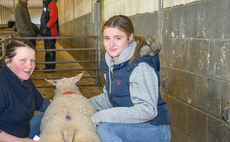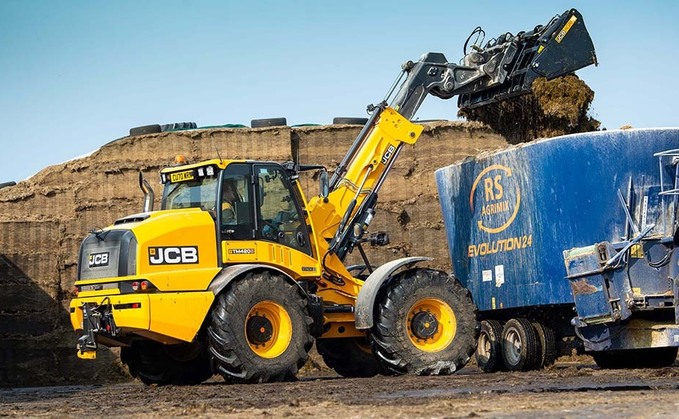
Fitted with an eight speed gearbox, a 173hp engine and high flow hydraulics, JCB's new TM420S would suggest it has all the ingredients to be a capable performer at a number of tasks. Richard Bradley gets behind the wheel to find out more.
Whether it be clamp climbing, feeding stock or generally weaving around a farm yard, JCB's TM pivot steer, telehandler loader range has found favour on many mixed and livestock farms, both for its performance and jump on and drive operation.
Originally introduced in 1995 with the 409 Telemaster, the TM range now spans six models with lift capacities ranging from 1.8 to 4.1 tonnes. And, it is at the latter end of the spectrum where, as ever, users are seeking more power and more efficiency. With this in mind, the British firm pulled the wraps off its TM420 at Agritechnica in 2017.
Despite sharing the engine, transmission and operator station with the TM320S, a quick glance at the 420 was all you needed to know this was a different weapon altogether. For users looking to shift material in a hurry, the 420 provided a sizeable jump against the 320S. However, its performance as a climber was rather lack-lustre.
Fast forward three years, and JCB finally gave the 420 what it needed all along, more horses and a more refined transmission with torque lockup to climb its way to infinity and beyond.
So, with the offer of an exclusive first drive of the hotly anticipated loader, we sent it to a large-scale dairy farm to see what the 420S is like to live with. Here, a TM420 is in daily use, having clocked up more than 3,000 hours feeding, mucking out pens and assisting in clamp construction during the silly season, all areas which made for some interesting comparison.
Engine and transmission
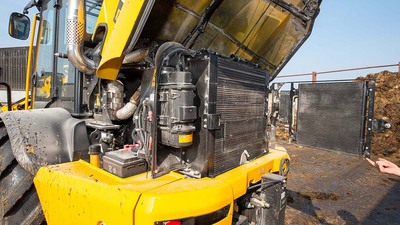
Under the bonnet, which can only be described as having enjoyed lockdown a little too much, is a 4.8-litre, four-cylinder JCB engine which meets Stage 5 emissions with a DPF and DOC. Engineers have given it a vital adrenalin injection with 173hp now on tap - a sizeable jump from the previous 145hp in the standard 420.
Thanks to the loader's sheer size, the engine and all exhaust after treatment equipment is kept well away from the cab, helping to reduce heat and noise.
As for the transmission, it is out with the old six-speed torque converter ‘box, and in with an eight-speed unit.
Torque lock is available in all eight of its gears, with gearing set to achieve 50kph. A 40kph version is also available, able to achieve its top speed at lower revs. Gears one to four are shifted manually via buttons on the joystick, whereas five to eight can either be shifted manually or looked after by the automatic mode which takes into account engine load and throttle position for more intelligent shifting. Along with new, smarter shifting, the mechanical park brake has now been replaced by an electrically operated one on 50kph machines, a much neater and easier to operate solution.
To cope with the extra grunt, the entire transmission has been beefed up, with extra gears allowing more overlap at ‘everyday' speeds around the yard. Greater overlap also allows the TM to engage torque lock in first gear, and to shift right up to eighth without disengaging.
Where the previous six-speed transmission may leave the operator longing for a gear in-between third and fourth, a shift worth noting as being a sizeable leap for general yard duties, the new eight-speed affords more options and much smoother up and down shifting, whether at idle or revving hard.
JCB has also given the 420S a more responsive torque converter which allows the large loader to really pick its feet up as soon as you flick it into drive. In comparison, the older 420 takes a few more revs to get its wheels turning.
Trans cont...
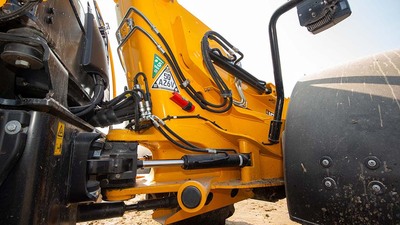
Axles remain the same as previous 420 machines, with brakes and limited slip differentials in both front and rear axles. However, drivelines do get a noticeable beefing up to cope with the stresses and strains of clamp work.
Users who often take their TM machines down the road may think of 50kph as a nightmare waiting to happen. Fear not, the 420S feels well planted at road speeds, far more stable than the standard 420 does, thanks to its revised steering setup. It was equally happy when dragging more than 10 tonnes of fertiliser along on a dolly trailer without really breaking into a sweat.
Previously, a variable ratio steering system was fitted to the 420, however, a fixed system with larger steering valves and rams has now been fitted.
Engine cont...
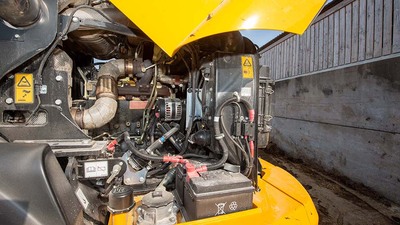
In terms of practicalities, JCB has improved the engine bay itself. The transmission now has dedicated filler and dipstick lines - the latter is much easier to fathom. And you will no longer spill half your windscreen washer fluid, as a filler neck is now featured.
Putting the 420S to work shows a step-up in performance over the standard 420. Whether it is grabbing silage from the pit or mucking out pens, the pushing power is impressive and that is before you get it on the clamp. Here the S model leaves the standard machine in its wake.
Equipped with a 2.7-metre push-off buck rake, clamp climbing capabilities are very impressive. In heavy and slightly green first cut grass, the TM takes pushing through a load in its stride. In first or second gear with lockup engaged, its progress up the pit is spirited.
Shod on meaty looking 620mm tyres, the 420S has ample traction on the pit and at the rare sign of wheel spin, a slight feathering of the throttle keeps the loader climbing.
Hydraulics and handling
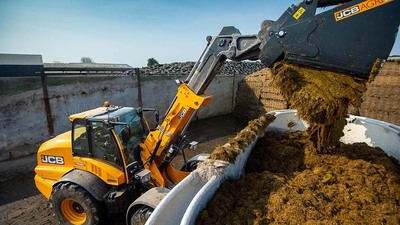
To suit the demanding workload of clamp construction, JCB has upped the ante in terms of hydraulic performance, with the full 160 litres/minute now available at 1,700rpm thanks to a larger pump. While this is noticeable around the yard filling the diet feeder, it comes into its own on the pit where flicking the fork no longer drains all power which allows you to keep climbing at a rate of knots.
Along with a low-revving nature to hoist loads, the 420S benefits from regenerative hydraulics, whereby the boom lowers using gravity, allowing oil to be utilised elsewhere. While not only reducing the amount of fuel burned, it helps to keep noise in the cab low and makes the whole job feel a bit quieter, calmer and more relaxed.
Headstock
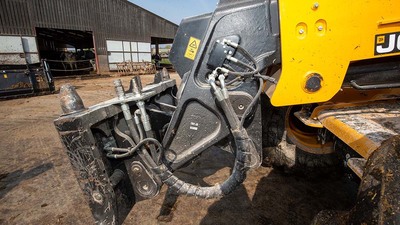
At the business end of the TM on our test model was a hefty looking pin and cone headstock - JCB's Q-fit and other makes of industrial carriages are also available. The casting which houses the headstock pivot points looks capable of withstanding some serious strains, and Z-bar crowd linkage provides plenty of tear out force.
With a 1.8cu.m shear grab up-front, the 420S showed little sign of cocking a wheel, despite hoisting almost three-tonnes over the mixer at a considerable amount of steering lock.
To suit high flow hydraulic applications such as straw spreaders, the 420S boasts up to 100 litres/minute available at the couplers at just 1,200rpm. This high flow allowed the loader to fire straw through a Spread a Bale bale dispenser with little hassle or hesitation. For operations requiring less oil, flow can be dialled back in the cab, and constant pumping can also be engaged for sweepers or bedding attachments. However, these are jobs which do show the 420's size when put up against a TM320.
Cab and controls
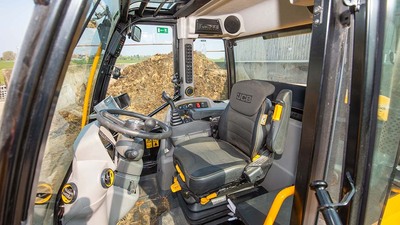
To suit both users spending hour after hour in the saddle, and those feeding stock regularly hoping on and off, JCB has made some welcome refinements in the cab.
From first glancing at the new TM, its loading-shovel esque styling instantly makes the outgoing models appear somewhat dated.
Access into the cab is good with three wide steps and a gas-strut assisted door holding itself open without needing to be locked fully back. However, for those who prefer natural ventilation, the gas strut can be removed and the door locked back fully.
For those users more likely to keep their door shut, JCB has made some decent improvements to the air conditioning system which is now better sealed. Also, users who regularly battle the British weather to keep cab windows clear may be interested to see a heated front windscreen, as is now common in the automotive world, added to the option sheet. And, for once, it is a practical solution which is not going to cost an arm and a leg, retailing at £295.
cab cont...

The windscreen itself is one of the many notable differences once you reach the perch. Thanks to a new slim-line crossbar between the curved windscreen and roof screen, views to raised implements are virtually unobstructed, meaning you no longer need to strain yourself to see how much material is flowing out of the bucket. Angled roof grills also help views at maximum height and a roof wiper is standard fitment on the 420S.
Keeping on the topic of wipers, the front unit is now larger and covers almost from edge to edge for improved views to the wide-angle mirrors, which are well worth an option to tick.
Meanwhile, the reversing camera is now standard fitment, and JCB says a separate camera to view the pickup hitch is an option.
TM drivers will now rejoice as the steering column adjustment system can now be moved and positioned freely, via the use of a gas strut. While it does not quite offer the same amount of movement as the set and forget system used in the firm's wheeled loading shovels, it is a major improvement over the old setup.
Up the right-hand B pillar is a new row of blister buttons looking after hydraulic and transmission functions, boom suspension, and some clever new lighting features.
Lights can be switched individually, or set to a single master switch. Auto-light functions can also be programmed, including reversing lights and boom lights which automatically switch off at low levels to help reduce glare. ‘Follow me home' lights are also featured, which along with step lights make a big difference when trying to navigate your way around a dark silage clamp.
Another clever feature is the ability to program the function of the bottom button on the armrest mounted joystick. A number of machine settings can be switched, most notably torque lock or work lights. This proved extremely handy when trying to navigate a silage clamp in darkness, quickly flicking lights on and off to prevent dazzling the other loader operator on the pit.
Finally, no longer do you have to suffer the frustrating clamber back into the cab, having forgotten to dump the auxiliary lines, as a depressurisation button is now fitted by the cab steps.
Verdict
JCB's engineers have certainly been busy on the TM420S. The standard 420 has proved itself as a materials handler, but thankfully the S offers performance and efficiency gains by the bucket load, both around the yard and most impressively on the pit.
With a good operator at the wheel and a 3m fork on the front, it would be easy to see the 420S keeping up with all but the largest of foragers firing grass into the clamp.
Take it away from the pit and the bendy brute will happily chuck its hand at virtually any job you can think of. Unlike its loading shovel counterparts, the 420S does not require toe tip buckets to load into lorries or mixers, neither does it take as much competence to navigate through traditional farm yards.
























